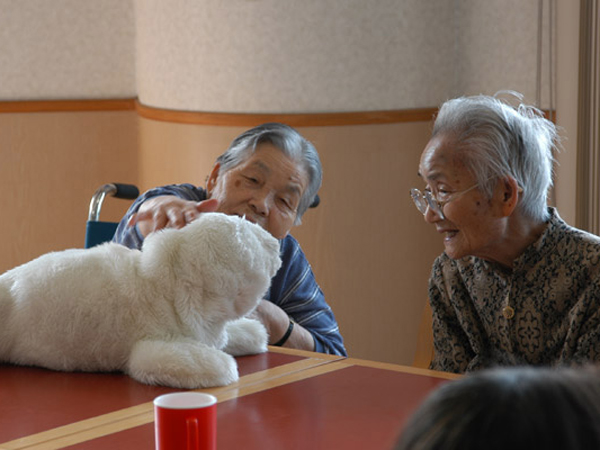 |
| Ruth, who is 100-years-old, doing pilates in New York City, as seen at advancedstyle.blogspot.com |
Last month the UNFPA reported that the world's population had reached 7 billion. Of this number, 893 million people are aged over 60 and the figure is likely to nearly triple to 2.4 billion by the middle of the century (CNN). This week WGSN-homebuildlife published a report that investigates the needs of the new 21st century, 60+ consumer and how architecture and design is responding to their needs. Subscribers can see the full report online here. Below are some of the product highlights from the report.
 |
| The Aid by Egle Uginataite |
Lithuanian designer Egle Uginataite recently introduced a high-tech walking stick that keeps track of blood pressure, heart rate and temperature, while communicating directions via a pair of headphones. Additional features of the cane are an emergency button that dials a help centre and built-in navigator and LCD display. The design won Fujitsu's 2011 design award, an international award based in Japan.
 |
| iHealth running on iPad and iPhone |
Over the past decade many efforts have been made, especially in Japan, to introduce robots into the care system. However, in most cases they have been deemed too expensive, impracticable and impersonal. Instead of trying to replicate human interaction the care technology industry is now investing in developing unintrusive, non-robot technology; these devices will fit seamlessly into our day to day lives.
Combined with an iPhone application, iHealth's BP3 blood pressure monitor allows the user a cheap and easy way to see the connection between their blood pressure and their daily life by creating detailed graphs that track blood pressure readings. By connecting personal health care products to mobile devices, the user can instantly track personal health information over time and share that information easily with physicians or caregivers.
 |
| Paro Therapeutic Robot |
While many designs are aimed at helping patients physically, we are also seeing an increase in products catered to those with diseases that effect the brain such as alzheimers and dementia. These designs soothe and comfort, focusing on exercising the brain and helping those suffering from memory loss.
In Japan, a robotic pet seal design called Paro is enjoying some success. Targeted at elderly people who are unable to take care of an animal, the therapeutic robot pets are used in nursing homes and hospitals, as well as by private individuals. More than 1,000 have been sold so far and, following a trial in a dementia centre in Copenhagen, 1,000 of the electronic pets were introduced into Danish nursing facilities this year.
The Paros have been programmed to provide seemingly empathic responses. The artificial intelligence and suite of sensors enable Paro to grow active or sleepy, show pleasure when held, and get angry when hit. They also understand simple words like greetings and compliments, and wll respond with calls and facial expressions.
Two of the most important factors in a achieving a good quality of life for senior citizens is maintaining a regular social network of friends and being able to get out and about to move around. Social networking and the internet were previously not associated with the elderly but as a generation of more computer-literate people approach the age of 60, the number of seniors using social networking sites will continue to grow.
Mikael Johansen decided to design the IC Social Communication Tool when he realised that his grandmother was having difficulty coping with emails, chats and video calls over the internet. The IC user enters their personal information and the device automatically creates an e-mail account and optional social media accounts. It is connected to the internet via 4g so there is no need for the user to have broadband internet in the home. The device gathers messages from contacts sent through all medias and displays them in a simple format so there is only one interface to get used to.
The IC also features voice recognition and a bi-directional touch-screen with built-in sensors to capture video. When the user points at something on the screen, it enlarges and the frame around the screen lets the user stabilise their hand. The environmentally-friendly wood and round form distinguishes it from similar technical products.
 |
| A computer rendering of the planned Boom community in Palm Springs, CA |
Architects are helping to change the image of housing for the elderly, either through the implementation of new technologies or simply a change in attitude and approach.
Being moved into a retirement home is a last resort for many families with elderly relatives, however BOOM is a planned 100 acre alternative retirement community in the desert of Palm Springs which hopes to change people's perceptions. BOOM was concieved by architect Matthias Hollwich of Hollwich Kushner and designed in collaboration with a group of 10 internationally renowned architects from New York, California and Europe.
Scheduled to open in late 2014, BOOM is aimed primarily at the LGBT community. There will be 300 residencies, four restaurants, ten swimming pools, four parks, one hotel, two nightclubs and four outdoor cafes, all arranged across eight neighbourhoods.
The fact that the development is shaped more like a Vegas resort than a nursing home is a message aimed directly at the target demographic of post-World War II baby boomers who, as BOOM explains, have a reputation for hedonism and a fear of aging. They are hoping that the resort will also attract a younger crowd of daytime visitors.







